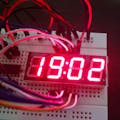1- Introduction
2- Material List:
3- Operation
Read moreStopwatches are very useful in several applications and made by yourself using an Arduino, it is really more interesting!
This project is really simple, easy to be assembled using few components and has an excellent accuracy and responsiveness including the following features:
- The stopwatch shows the time in minutes, seconds and tenth of seconds.
- The lap timer shows the time in seconds and hundreths of seconds.
- Internally the time count is in miliseconds by the clock of microcontroler.
1 / 2 • Stopwatch with Arduino Nano
- Arduino Nano (Uno R3 as optional)
- LED Display with MAX7219 (8 Digits x 7 Segments)
- Tactile Button Switches
- Breadboard
- Jumper Wires
1 / 5 • Arduino Nano
There are 3 tactile button to control the stopwatch:
- Left: Reset the Stopwatch
- Middle: Start/Stop the Stopwatch
- Right: Lap Time
The first 4 digits at left show the stopwatch time and the 4 digits at right are for the lap timer.
Notes:
- Due to the number of digits available in the LED display, the maximum time count is 9 min 59.9 seconds.
- For same reason, the lap timer is limited to 99.99 seconds.
- Beyond these limits, the symbols "----" indicate the overflow of time.
1 / 4 • Left Button = Reset / Middle Button = Start-Stop / Right Button = Lap Timer
7 projects • 341 followers
Mechanical Engineer in automotive industry since 1989. Coding and Arduino are my hobbies.



_ztBMuBhMHo.jpg?auto=compress%2Cformat&w=48&h=48&fit=fill&bg=ffffff)










_1x_bGT19vVAby.png?auto=compress%2Cformat&w=40&h=40&fit=fillmax&bg=fff&dpr=2)
_3u05Tpwasz.png?auto=compress%2Cformat&w=40&h=40&fit=fillmax&bg=fff&dpr=2)
Comments